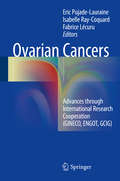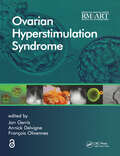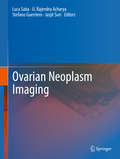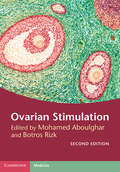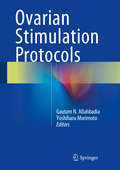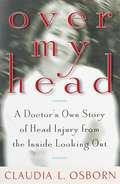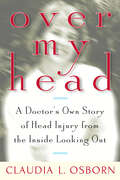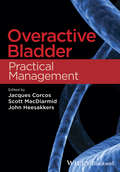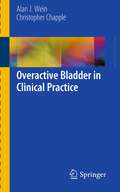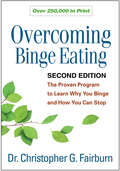- Table View
- List View
Ovarian Cancers
by Eric Pujade-Lauraine Isabelle Ray-Coquard Fabrice LécuruThis book provides an overview of the latestdevelopments in the concepts and management of ovarian cancer. The new datapresented throughout opens the way to radically different therapeuticapproaches. Surgery remains the core of ovarian cancer treatment, but itsultimate goal and the standard surgical procedure have evolved, giving rise tothe question of how to label expert centers for debulking surgery. Neo-adjuvantchemotherapy is becoming more popular and is also a new field for testing noveldrug combinations. Over recent years, ovarian cancer managementhas embraced molecular biology. It is now more correct to talk about cancers ofthe ovary rather than ovarian cancer, since it is not a unique disease butseveral entities with different molecular drivers. The significant advances indrugs targeting the microenvironment or the tumor cell DNA repair mechanismsare presented in detail together with exciting future perspectives. All these advances would not have been possiblewithout collaborative groups such as the GINECO group in France and theirintegration in wider clinical research networks at the European (ENGOT) andinternational (GCIG) level.
Ovarian Cancers: Evolving Paradigms in Research and Care
by Engineering Medicine National Academies of SciencesIn an era of promising advances in cancer research, there are considerable and even alarming gaps in the fundamental knowledge and understanding of ovarian cancer. Researchers now know that ovarian cancer is not a single disease—several distinct subtypes exist with different origins, risk factors, genetic mutations, biological behaviors, and prognoses. However, persistent questions have impeded progress toward improving the prevention, early detection, treatment, and management of ovarian cancers. Failure to significantly improve morbidity and mortality during the past several decades is likely due to several factors, including the lack of research being performed by specific disease subtype, lack of definitive knowledge of the cell of origin and disease progression, and incomplete understanding of genetic and non-genetic risk factors. Ovarian Cancers examines the state of the science in ovarian cancer research, identifies key gaps in the evidence base and the challenges to addressing those gaps, considers opportunities for advancing ovarian cancer research, and examines avenues for translation and dissemination of new findings and communication of new information to patients and others. This study makes recommendations for public- and private-sector efforts that could facilitate progress in reducing the incidence of morbidity and mortality from ovarian cancers.
Ovarian Hyperstimulation Syndrome (Reproductive Medicine and Assisted Reproductive Techniques Series)
by Jan Gerris François Olivennes Annick DelvigneMajor advances have recently been made in our understanding of Ovarian Hyperstimulation Syndrome (OHSS). These include improving classification, recognizing primary and secondary risk factors, manipulating and monitoring ovarian stimulation, handling risky situations, and elucidating the underlying pathophysiologic mechanisms of the syndrome. As su
Ovarian Neoplasm Imaging
by Jasjit S. Suri U. Rajendra Acharya Luca Saba Stefano GuerrieroDiagnostic and pre-operative imaging has become increasingly adopted throughout the field of gynecology. In particular accurate preoperative analysis of ovarian pathology can improve the selection of the correct therapeutical approach, to reduce the length of operations, maximize surgical technique, and can ultimately improve a range of operative outcomes. New imaging modalities have advanced to the point of high resolution, three-dimensional analysis of tissue anatomy, composition and perfusion. Ultrasonography (US), Computed tomographic (CT) and magnetic resonance (MR) imaging have recently emerged as outstanding non-invasive techniques for the detection and characterization of ovarian pathology. In particular, US has probably now imposed itself as the "state-of-the-art" technique to explore the ovarian neoplasm, thanks the technical advancement like texture analysis (MGV) and 3D potentialities, although MR with new sequences like the diffusion-weighted imaging and greater magnetic fields (3 Tesla or more) may become leading methods in the future. The purpose of this book is to cover all the imaging techniques, potential for applying such imaging clinically, and to offer present and future applications as applied to ovarian pathology with the most world renowned scientists in these fields. The book is designed according to the pathological classification of the benign and malignant ovarian neoplasm by presenting for each pathology the clinical setting followed by the imaging approach. At the end of each chapter a "focus concept" paragraph will be presented with take-home point for the readers.
Ovarian Stimulation
by Botros Rizk Mohamed AboulgharOvarian stimulation is the starting point of reproductive medicine but the procedure can result in adverse reactions particularly the dangerous ovarian hyperstimulation syndrome. Fully revised in line with modern practice of ovarian stimulation, this new edition is divided into six sections that cover mild forms, non-conventional forms, IVF, complications and their management, alternatives, and the practicalities of procedures. All aspects of ovarian stimulation are discussed including the different stimulation protocols from which to choose, the management of poor responders and hyper-responders, as well as stimulation in patients with PCOS. Comprehensively reviewing the modern approach to ovarian stimulation, the alternative procedures are also described, both in IVF and other methods of assisted reproduction. Written by leading experts on reproductive health and fertility, this book will assist infertility specialists, gynecologists, reproductive endocrinologists and radiologists in determining successful treatment for their patients.
Ovarian Stimulation Protocols
by Gautam N. Allahbadia Yoshiharu MorimotoOvarian Stimulation Protocols is a concise handbook that aims to deliver everything the reader needs to know for performing a risk-free ovarian stimulation for assisted reproductive technique (ART) and get a favorable outcome. Review of crucial issues such as the significance of monitoring ovarian stimulation, advantages and disadvantages of ovarian hyperstimulation versus minimal stimulation, and the use of various drug regimens and stimulation protocols for various patient sub-sets, will help clinicians in selecting the better or more appropriate protocols. The contributors of this book have leading scientific and clinical backgrounds, with years of experience to support their views. The book serves as a handy practical guide, targeting and settling clinical dilemma that ART practitioners commonly experience in their clinics, while providing a window to the newer developments.
Ovarian Toxicology
by Patricia B. HoyerToday, we are exposed to an increasing number of chemicals in the environment and there is a growing awareness of the effects of these chemicals on the ovaries. Infertility resulting from environmental exposures may not be obvious until the reproductive life span is waning. As such, the potential for xenobiotic-induced infertility needs to be bette
Over My Head
by Claudia L. OsbornFrom the Book: A Doctor's own story of head injury from the inside looking out.
Over My Head: A Doctor's Own Story Of Head Injury From The Inside Looking Out
by Claudia L. OsbornLocked inside a brain-injured head looking out at a challenging world is the premise of this extraordinary autobiography. Over My Head is an inspiring story of how one woman comes to terms with the loss of her identity and the courageous steps (and hilarious missteps) she takes while learning to rebuild her life. The author, a 45-year-old doctor and clinical professor of medicine, describes the aftermath of a brain injury eleven years ago which stripped her of her beloved profession. For years she was deprived of her intellectual companionship and the ability to handle the simplest undertakings like shopping for groceries or sorting the mail. Her progression from confusion, dysfunction, and alienation to a full, happy life is told with restraint, great style, and considerable humor.
Over My Head: A Doctor's Own Story of Head Injury from the Inside Looking Out
by Claudia L. OsbornThis physician&’s &“inspiring&” account of overcoming a devastating brain injury &“will assist patients, families, and friends enduring the same difficulties&” (Library Journal). Locked inside a brain-injured head looking out at a challenging world is the premise of this extraordinary memoir chronicling the long process of adjustment and rehabilitation after a fateful, helmetless bike ride. In Over My Head, Claudia Osborn, a doctor and clinical professor of medicine, recounts coming to terms with the loss of her identity and the courageous steps (and hilarious missteps) she took while learning to rebuild her life. For years, Osborn was deprived of the career she loved and the intellectual companionship of her professional colleagues—and the ability to handle the simplest undertakings like shopping for groceries or sorting the mail. Her progression from confusion, dysfunction, and alienation to a full, happy life is told here with restraint, great style, and considerable humor. &“Exceptionally well-written and engaging.&” —Publishers Weekly
Over the Influence
by Patt Denning Jeannie LittleTwelve-step programs that insist on abstinence are beneficial to many--but what about the millions of Americans who try to quit and fail, just want to cut down, or wish to work toward sobriety gradually? This groundbreaking book presents the Harm Reduction approach, a powerful alternative to traditional treatment that helps users set and meet their own goals for gaining control over drinking and drugs. The expert, empathic authors guide readers to figure out which aspects of their own habits may be harmful, what they would like to change, and how to put their intentions into action while also dealing with problems that stand in the way, such as depression, stress, and relationship conflicts. Based on solid science and 40+ years of combined clinical experience, the book is packed with self-discovery tools, fact sheets, and personal accounts. It puts the reader in the driver's seat with a new and empowering roadmap for change.
Over the Influence, Second Edition: The Harm Reduction Guide to Controlling Your Drug and Alcohol Use
by Patt Denning Jeannie Little"Just say no" just doesn't work for everyone. If you've tried to quit and failed, simply want to cut down, or wish to work toward sobriety gradually, join the many thousands of readers who have turned to this empathic, science-based resource--now thoroughly revised. A powerful alternative to abstinence-only treatments, harm reduction helps you set and meet your own goals for gaining control over alcohol and drugs. Step by step, the expert authors guide you to figure out: *Which aspects of your habits may be harmful. *How to protect your safety and make informed choices. *What changes you would like to make. *How to put your intentions into action. *When it's time to seek help--and where to turn. Updated to reflect a decade's worth of research, the fully revised second edition is even more practical. It features additional vivid stories and concrete examples, engaging graphics, new worksheets (which you can download and print for repeated use), "Self-Reflection" boxes, and more. Mental health professionals, see also the authors' Practicing Harm Reduction Psychotherapy, Second Edition.
Overactive Bladder
by Scott Macdiarmid Jacques Corcos John HeesakkersOveractive Bladder: Practical Management provides urologists, gynecologists and other health practitioners with a comprehensive clinical guide to this very common problem, resulting in a perfect resource to consult time and time again. Beginning with an introductory section covering the definition and pathophysiolgy of OAB, it then moves on to cover evaluation, first-line management, second-line management and finally surgery. Well-illustrated throughout, each chapter begins with a key points box outlining the most important take-home messages. Also included are clear management algorithms to aid decision-making, 'Do's and Don't' boxes to help avoid errors made, key references to the top journal articles, and the very latest guidelines from the EAU, AUA and other major urology societies. Chapters are written by the top names in the field and the entire book is expertly edited by Jacques Corcos, John Heesakkers and Scott MacDiarmid. The result is a consistent, comprehensive and fully up to date approach to OAB, providing urologists managing patients with this condition with rapid access, specialist clinical guidance.
Overactive Bladder in Clinical Practice
by Alan J. Wein Christopher R. ChappleThe book provides a timely and comprehensive update on the overactive bladder (OAB) syndrome. The symptoms of urgency, with or without urge incontinence, usually with frequency or nocturia, now defined as the overactive bladder syndrome, have become a hot topic in urology, gynecology and urogynecology. Epidemiological data show very high disease prevalence (19%), particularly when compared with other chronic conditions such as diabetes (2%) and asthma (7%). OAB symptoms impact severely on patient's quality of life, causing significant impairment of patient vitality and limiting their physical role, similar to diabetes. The OAB syndrome involves all age groups, both sexes and is frequently found in neurogenic patients. This book will cover all aspects of OAB epidemiology, economics, pathophysiology, conservative, pharmaceutical and surgical and will be invaluable reading for residents and trainees in urology, gynecology and urogynecology.
Overcoming Acute and Chronic Pain: Keys to Treatment Based on Your Emotional Type
by Marc S. Micozzi Sebhia Marie DibraFind the holistic treatment that will work best for you based on your emotional type and specific pain condition• Provides an easy questionnaire to determine your emotional type and an interactive self-assessment for finding the right pain treatment for your condition• Explores mind-body treatments for many common pain conditions, including arthritis, back pain, fibromyalgia, irritable bowel, migraines, carpal tunnel, and PTSD• Reviews the scientific evidence in support of acupuncture, biofeedback, hypnosis, massage, chiropractic, yoga, herbs, and essential oilsThroughout history many healing traditions have focused on analgesia--the alleviation of pain--an area in which modern medicine provides few options beyond narcotics, steroids, and surgery. For those seeking drug- and surgery-free alternatives or complements to conventional pain management, the choices can be overwhelming. How do you know which method will work for you?In this guide to safe and effective natural therapies for acute and chronic pain, authors Marc S. Micozzi, M.D., Ph.D., and Sebhia Marie Dibra explain how your emotional boundary style--how you react to emotional, social, environmental, and physical stresses--affects which complementary treatments will work best for you. Providing an easy questionnaire to determine your emotional type and an interactive self-assessment for finding the right pain treatment for your condition, they explore the effectiveness of mind-body treatments for each emotional type and for many common pain disorders, including arthritis, back pain, fibromyalgia, irritable bowel, ulcer, migraine headaches, carpal tunnel, anxiety, PTSD, and other chronic pain conditions. They review the available research and scientific evidence in support of each therapy, suggesting only well-established, safe, and clinically proven alternative treatments, such as acupuncture, biofeedback, hypnosis, massage, chiropractic, yoga, herbs, and essential oils.Approaching pain holistically, they reveal how pain should be understood as a dynamic condition--an interaction between mind and body as well as between patient and therapy--and how your emotional type is key to long-lasting and successful results.
Overcoming Anger and Irritability, 2nd Edition: A self-help guide using cognitive behavioural techniques
by Dr William DaviesConstant irritability or flashes of bad temper can cause difficulties in relationships with friends, family or colleagues and leave us feeling unhappy and exhausted. This fully updated and revised edition of William Davies' bestselling title is for anyone struggling to control their rage and regretting inappropriate reactions.It explains clearly what provokes anger and what we can do to prevent it. Techniques based on Cognitive Behavioural Therapy (CBT) offer a positive approach with long-term goals in mind and show how you can stay cool and successfully handle situations that would tax even the most easy-going person.Overcoming self-help guides use clinically-proven techniques to treat long-standing and disabling conditions, both psychological and physical. READING WELL This book is recommended by the national Reading Well Books on Prescription scheme for England delivered by The Reading Agency and the Society of Chief Librarians with funding from Arts Council England and Wellcome. www.reading-well.org.uk
Overcoming Anger and Irritability, 2nd Edition: A self-help guide using cognitive behavioural techniques (Overcoming Books)
by Dr William DaviesConstant irritability or flashes of bad temper can cause difficulties in relationships with friends, family or colleagues and leave us feeling unhappy and exhausted. This fully updated and revised edition of William Davies' bestselling title is for anyone struggling to control their rage and regretting inappropriate reactions.It explains clearly what provokes anger and what we can do to prevent it. Techniques based on Cognitive Behavioural Therapy (CBT) offer a positive approach with long-term goals in mind and show how you can stay cool and successfully handle situations that would tax even the most easy-going person.Overcoming self-help guides use clinically-proven techniques to treat long-standing and disabling conditions, both psychological and physical. READING WELL This book is recommended by the national Reading Well Books on Prescription scheme for England delivered by The Reading Agency and the Society of Chief Librarians with funding from Arts Council England and Wellcome. www.reading-well.org.uk
Overcoming Anger in Your Relationship
by W. NayHas your relationship become a battlefield? Does your partner's sarcasm, irritability, or hostility make you wonder where the closeness and trust have gone-and how much more you can take? If anger is poisoning your relationship, this book offers a powerful antidote. Anger expert W. Robert Nay provides clear-cut, practical techniques for responding productively to inappropriate expressions of anger. Learn how anger gains a foothold in a couple's life, why your usual responses may unwittingly reward bad behavior, and how to stand up for yourself in ways that promote lasting change. Self-quizzes and step-by-step suggestions for dealing with different types of angry behavior are illustrated with true-to-life examples. Grounded in psychological science, the strategies in this book are simple yet surprisingly effective. Try them for yourself-and for the person you love.
Overcoming Antimicrobial Resistance of the Skin (Updates in Clinical Dermatology)
by Stephen K. Tyring Omar Lupi Angela Yen Moore Stephen Andrew MooreThis book is a thorough, practical review of the challenges facing clinicians treating skin microbes and how to combat these therapeutic dilemmas. It expresses the critical public health concern of antimicrobial resistance and shows how microorganisms are developing the ability to halt the progress of antimicrobials like antibiotics, antivirals, and antifungals. Chapters are grouped together in five sections for ease of use. The first three sections of the book convey foundational information on the mechanisms of antibiotics, antivirals, and antifungals resistance, as well as the implications of lack of vaccination. The fourth section then turns to the specifics of drug resistance for protozoan and helminth infections focusing primarily on initial and subsequent resistance to treatment. The book closes with a discussion on the potential solutions of innovative therapy including new delivery mechanisms, broad-spectrum antibiotics, phytocompounds, and biofilms. Chapters feature magnified, microscopic photos for identifying structures as they appear on the skin. Part of the Updates in Clinical Dermatology series, Overcoming Antimicrobial Resistance of the Skin is an important resource relevant during the COVID-19 pandemic, and is written for all medical healthcare professionals.
Overcoming Anxiety Without Fighting It: The powerful self help book for anxious people from Dr Tim Cantopher, bestselling author of "Depressive Illness: The Curse of the Strong"
by Tim CantopherYOU DON'T HAVE TO STRUGGLE WITH ANXIETY. WHETHER YOU DEVELOPED IT RECENTLY, OR YOU'VE BEEN LIVING WITH IT FOR YEARS, YOUR ANXIETY CAN BE TREATED. Expert psychiatrist and bestselling author Dr Tim Cantopher has helped hundreds of people just like you, and in Overcoming Anxiety Without Fighting It, he gives you tried and proven strategies for escaping the fear that stalks you. Discover a series of simple, manageable lifestyle skills and strategies that will make an immediate difference to your life, as well as practical suggestions for longer-term changes, including advice on how, when, and what sort of professional help to seek. At the heart of this warm, supportive and expert book are the author's decades of experience with people just like you, and with this experience comes a message of hope, and reassurance. Stick with the changes you are going to make, and seek the support you need, and your life will no longer be dominated by fear.'I'm speaking to you now - if you are going to gain the relief from your symptoms which I hope for you, you'll need to promise me and yourself one thing from the start: that you'll try your hardest not to judge yourself and how well or badly you're doing at getting better.' - Dr Tim Cantopher
Overcoming Anxiety Without Fighting It: The powerful self help book for anxious people from Dr Tim Cantopher, bestselling author of "Depressive Illness: The Curse of the Strong"
by Tim Cantopher'I'm speaking to you now - if you are going to gain the relief from your symptoms which I hope for you, you'll need to promise me and yourself one thing from the start: that you'll try your hardest not to judge yourself and how well or badly you're doing at getting better.' - Dr Tim CantopherWhether you developed it recently, or have been living with it for years, your anxiety can be treated. Expert psychiatrist and bestselling author Tim Cantopher has helped hundreds of people like you, and in Overcoming Anxiety Without Fighting It, he'll give you tried and proven strategies for escaping the fear that stalks you. The first step on the path to feeling better is to accept your anxiety, and to stop struggling with it. While you come to terms with this, Dr Cantopher will set out a series of simple, manageable lifestyle skills and strategies that will make an immediate difference. There are also practical suggestions for longer-term changes - and advice on how, when, and what sort of professional help to seek. At the heart of this warm, supportive and expert book are the author's decades of experience with people just like you, and with this experience comes a message of hope, and reassurance. Stick with the changes you are going to make, and seek the support you need, and your life will no longer be dominated by fear.
Overcoming Anxiety, 2nd Edition: A self-help guide using cognitive behavioural techniques
by Helen KennerleyOvercoming app now available.Fully updated edition of the bestselling self-help book, now recommended on the national Books on Prescription scheme. This ever-popular guide offers a self-help programme, written by one of the UK's leading authorities on anxiety and based on CBT, for those suffering from anxiety problems. A whole range of anxieties and fears are explained, from panic attacks and phobias to obsessive compulsive disorder (OCD) and generalised anxiety. It includes an introduction to the nature of anxiety and stress and a complete self-help programme with monitoring sheets based on Cognitive Behavioural Therapy. The following websites may offer useful further information on anxiety disorders: www.social-anxiety.org.uk www.stress.org.uk www.triumphoverphobia.com
Overcoming Anxiety, 2nd Edition: A self-help guide using cognitive behavioural techniques (Overcoming Books)
by Helen KennerleyHIGHLY COMMENDED for the British Medical Awards book prize for Popular MedicineFully updated edition of the bestselling self-help book, now recommended on the national Reading Well scheme. This ever-popular guide offers a self-help programme, written by one of the UK's leading authorities on anxiety and based on CBT, for those suffering from anxiety problems. A whole range of anxieties and fears are explained, from panic attacks and phobias to obsessive compulsive disorder (OCD) and generalised anxiety. It includes an introduction to the nature of anxiety and stress and a complete self-help programme with monitoring sheets based on Cognitive Behavioural Therapy. The following websites may offer useful further information on anxiety disorders: www.social-anxiety.org.uk www.stress.org.uk www.triumphoverphobia.com
Overcoming Anxiety, Stress and Panic: A Five Areas Approach (Overcoming)
by Christopher WilliamsOvercoming Anxiety, Stress and Panic uses the proven and trusted five areas model of cognitive behavioural therapy (CBT) to help people experiencing a range of symptoms associated with these conditions. For the third edition, new workbooks are included on: obsessive compulsive disorder (OCD), using medication, and planning for the future.CBT workbo
Overcoming Binge Eating, Second Edition
by Christopher G. FairburnThis trusted bestseller provides all the information needed to understand binge eating and bring it under control, whether you are working with a therapist or on your own. Clear, step-by-step guidelines show you how to: *Overcome the urge to binge. *Gain control over what and when you eat. *Break free of strict dieting and other habits that may contribute to binges. *Establish stable, healthy eating patterns. *Improve your body image and reduce the risk of relapse. This fully updated second edition incorporates important advances in the understanding and treatment of eating disorders. It features expanded coverage of body image issues and enhanced strategies for achieving--and maintaining--a transformed relationship with food and your body.
